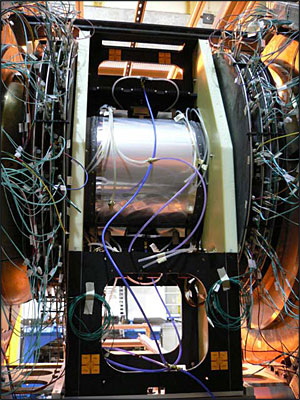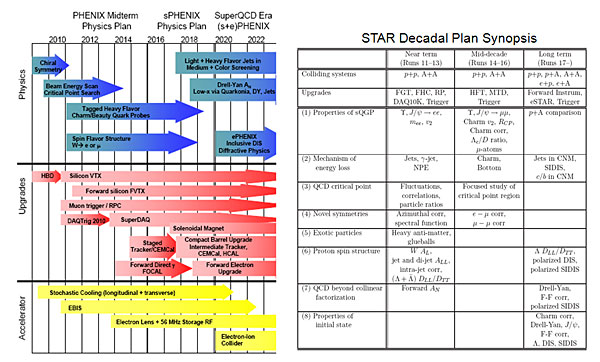Run 11 Update, RHIC Future Planning
January 11, 2011
By Steve Vigdor
Let me start by wishing all members of the RHIC users community a healthy and productive 2011. Then, I would like to bring you up to date on the upcoming Run 11 and a number of issues regarding planning for RHIC’s future.
Run 11
We are beginning cooldown of RHIC below 45K on Jan. 3, 2011. This is about a month later than was originally planned. Initially, a three-week delay in startup was granted to permit sufficient time for PHENIX to complete a very full shutdown schedule, which has seen installation of the entire new VTX detector, as well as completion of the new resistive plate chambers for the upgraded muon trigger system. However, that delay would have been necessitated in any case by a subsequent small fire in the relay system for the AGS radiation control access system. That fire has taught us a number of things that need to be improved in maintenance and awareness of flame retardance issues in areas where equipment was installed 40 or more years ago, when standards were not so rigidly enforced. We have found a temporary work-around for AGS access in Run 11, and will replace the old relay system by a new programmable logic control system for AGS access during the 2011 summer shutdown.
While AGS startup thus occurred a couple of weeks later than originally hoped, the good news is that good proton beam polarization from the AGS has been obtained almost from the start. Run 11 will start with roughly 10 weeks of 500 GeV polarized proton collisions. The machine will be operated closer to the 2/3-integer resonance than was possible during the last 500 GeV run in 2009, with the hope that this will lead to substantially improved beam polarization transmission to full energy. In addition to commissioning this new tune, we will be commissioning the new 9 MHz rf system that will hopefully lead to tighter vertex distributions for pp collisions. These features may make the commissioning time for the pp run somewhat longer than usual, but we hope it will result in significantly better performance. The RHIC polarimeter electronics have also been upgraded to ameliorate rate-dependence problems seen in the 2009 500 GeV run.
Upon recommendation from the Program Advisory Committee at its June 2010 meeting, we will be devoting a few shifts of beam time to explore whether pp collisions can be established at IP2 without significant degradation of the luminosity at STAR and PHENIX. If this is possible, it would permit a feasibility test for a transverse single spin asymmetry measurement for Drell-Yan dilepton production to be carried out in IP2 during 2012-13, pending receipt and approval of a full proposal for this AnDY project at the anticipated June 2011 PAC meeting. An initial suite of detectors largely borrowed from previous experiments has been set up in IP2 in anticipation of such a possibility. If this approach works, it will permit RHIC to begin to address a Nuclear Physics performance milestone associated with transverse spin asymmetries by its 2015 due date, and still allow devotion of IP2 to a planned Coherent Electron Cooling proof-of-principle test by 2014. The AnDY project would furthermore inform more detailed planning for a Drell-Yan spin asymmetry program at RHIC in the latter half of the new decade.

The PHENIX Vertex detector (VTX) installed on the beamline at PHENIX.
The pp portion of the run will also permit commissioning of the new PHENIX VTX detector with beam, in anticipation of an ~8-week following period of full-energy Au+Au collisions, with the primary goal of applying the VTX system to help distinguish bottom from charm quark production, in order to elucidate further the remaining mysteries surrounding quark energy loss in the Quark-Gluon Plasma. Other goals for Run 11 include a first look at U+U collisions using the new EBIS source (completed last summer and already commissioned in NSRL running), and filling in some of the collision energies skipped during the first Au+Au beam energy scan in Run 10.
Because Run 11 is starting a month later than originally planned, it is likely at best to be limited to about 26 cryoweeks of operation since we normally find running into July less cost-effective (power costs increase and machine and detector reliability typically decrease). It could be considerably shorter than that if Congress eventually passes FY2011 budget bills that cut budgets from the FY2010 levels. At the moment, the government is operating on a Continuing Resolution through March 4, so we will be well into the run before we know more about the FY2011 budget. This means that we will have to stay flexible throughout the run and use our weekly planning meetings to optimize RHIC’s impact within the unfolding budget reality.
LHC Heavy Ion Results and RHIC Decadal Planning
Hearty congratulations are due to our colleagues working on ALICE, CMS and ATLAS for the beautiful new results they have produced so quickly, as well as the further results anticipated to emerge soon, from the initial heavy-ion collision run at LHC. The results made public so far appear entirely consistent with earlier data from RHIC, indeed, they are often in remarkable quantitative agreement when similar kinematic coverage is considered. We may anticipate that this similarity will revive questioning about the need for operating two expensive colliders capable of studying QGP. Thus, it is critical that we address crisply over the coming months the compelling reasons that we anticipate RHIC operations to remain essential throughout the new decade for probing this unique form of strongly interacting matter.
Pursuant to a charge I gave the collaborations a year ago, PHENIX and STAR have now completed Decadal Plans outlining their science goals and upgrade concepts through about 2020. The documents, which represent an enormous investment of energy and analysis by both collaborations, are accessible at www.bnl.gov/npp (click on the links under “Decadal Planning for RHIC Experiments,” about halfway down the page). We are currently working on finding dates for a special PAC meeting sometime this spring to provide feedback on these two Decadal Plans. We thus anticipate two PAC meetings in 2011, with the second being devoted as usual to consideration of Beam Use Proposals.
Following the PAC meeting dedicated to evaluation of the Decadal Plans, I am planning a Users Workshop on Future Strategy for RHIC, in the spring-to-summer time period. I want this workshop to be a first step in forging a user community consensus on the optimal long-term strategy for RHIC to be presented at the next Nuclear Physics Long Range Plan (LRP), for which Town Meetings could start as early as Fall 2012. There are many interconnected issues to consider, including: complementarity of RHIC and LHC; funding constraints for U.S. Nuclear Physics as a third major user facility (FRIB) begins operation around 2018; the most compelling heavy-ion collision measurements that require RHIC and realizable upgrade plans; the transition to a possible future Electron-Ion Collider (EIC); likely funding constraints on construction of EIC; adaptation of STAR and PHENIX to ep and eA collisions; the need for, and technical issues in, permitting AA, pp, eA and ep collisions all to be pursued in the future evolution of RHIC. It will be critical that we go into the LRP exercise with a viable strategy for success with user buy-in. I will be engaging both collaborations and the Users Executive Committee in helping to plan this very important workshop. Please stay tuned for details about timing and agenda.
EIC Progress
The 2-month Institute for Nuclear Theory program on “Gluons and the Quark Sea at High Energies: Distributions, Polarization, Tomography” during Fall 2010 produced considerable progress on the science case for EIC. The design goal parameters for BNL and JLab machine designs began to converge, simplifying planning of the science program. Furthermore, there was significant crystallization of a set of “golden” experiments with physics goals that are crisply communicated and clear implications for detector requirements. Tables summarizing some of this crystallization can be found in various rapporteur talks given during the final week’s workshop, at http://www.int.washington.edu/talks/WorkShops/int_10_3/. Another positive development during this past Fall was awarding of initial funding for several EIC-relevant accelerator R&D projects by DOE’s Office of Nuclear Physics. Among the approved R&D projects is a BNL-JLab-Tech X collaboration leading toward a proof-of-principle demonstration of Coherent Electron Cooling of hadron beams at RHIC.
The next steps in EIC planning include the following developments and events anticipated for the coming year: an imminent first call for generic (site non-specific) detector R&D proposals relevant to EIC and appointment of an advisory committee to recommend which proposals should receive funding; an international EIC Advisory Committee (EICAC) meeting in close proximity to DIS2011, planned for Newport News in mid-April; drafting of a science white paper for the collider by the end of 2011; reviews of eRHIC machine technical designs and costing. I hope that these developments will also be accompanied by substantial progress on various accelerator R&D projects now under way, by comparable design and costing reviews for the JLab EIC design, and by at least initial costing of realizable EIC detectors. If you are interested in participating in any of these developments, do not hesitate to contact me for details on how you may get involved.
2011-2192 | INT/EXT | Newsroom










